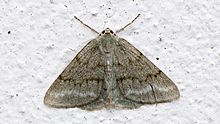Pseudoterpna coronillaria
Appearance
| Pseudoterpna coronillaria | |
|---|---|

| |
| Scientific classification | |
| Domain: | Eukaryota |
| Kingdom: | Animalia |
| Phylum: | Arthropoda |
| Class: | Insecta |
| Order: | Lepidoptera |
| Family: | Geometridae |
| Genus: | Pseudoterpna |
| Species: | P. coronillaria
|
| Binomial name | |
| Pseudoterpna coronillaria | |
| Synonyms | |
| |
Pseudoterpna coronillaria, the Jersey emerald or gorse emerald, is a moth of the family Geometridae. The species was first described by Jacob Hübner in 1796. It is known from Spain, Portugal, the Pyrenees, western and southern France, Corsica, Sardinia, Sicily, Italy, Samos, Rhodes, Turkey, Israel, Lebanon, northern Jordan and North Africa. It has not been reported from mainland Great Britain, but is present on Jersey, where it was previously overlooked as a form of the grass emerald, until 2001 when it was correctly identified.
The wingspan is 36–40 millimetres (1.4–1.6 in).
They are on wing in June and July in western Europe.[3]
The larvae feed on Genista tinctoria, Ulex species and broom.[4]
Subspecies
[edit]- Pseudoterpna coronillaria coronillaria (Spain, Portugal, the Pyrenees, western and southern France, Corsica, Sardinia, north-western Italy up to northern Tuscany)
- Pseudoterpna coronillaria algirica Wehrli, 1929 (North Africa)
- Pseudoterpna coronillaria cinerascens (Zeller, 1847) (western Turkey, Samos, Rhodes)
- Pseudoterpna coronillaria axillaria Guenée, [1858] (southern Turkey, Lebanon)
- Pseudoterpna coronillaria halperini Hausmann, 1996 (Israel, northern Jordan)
- Pseudoterpna coronillaria flamignii Hausmann, 1997 (central and southern Italy, Sicily)
References
[edit]- ^ Fauna Europaea
- ^ Pitkin, Linda M.; Han, Hongxiang; James, Shayleen (June 11, 2007). "Moths of the tribe Pseudoterpnini (Geometridae: Geometrinae): a review of the genera" (PDF). Zoological Journal of the Linnean Society. 150 (2): 334–412. doi:10.1111/j.1096-3642.2007.00287.x. Archived from the original on April 25, 2012.
- ^ UKMoths
- ^ Hantsmoths
External links
[edit]Wikimedia Commons has media related to Pseudoterpna coronillaria.
